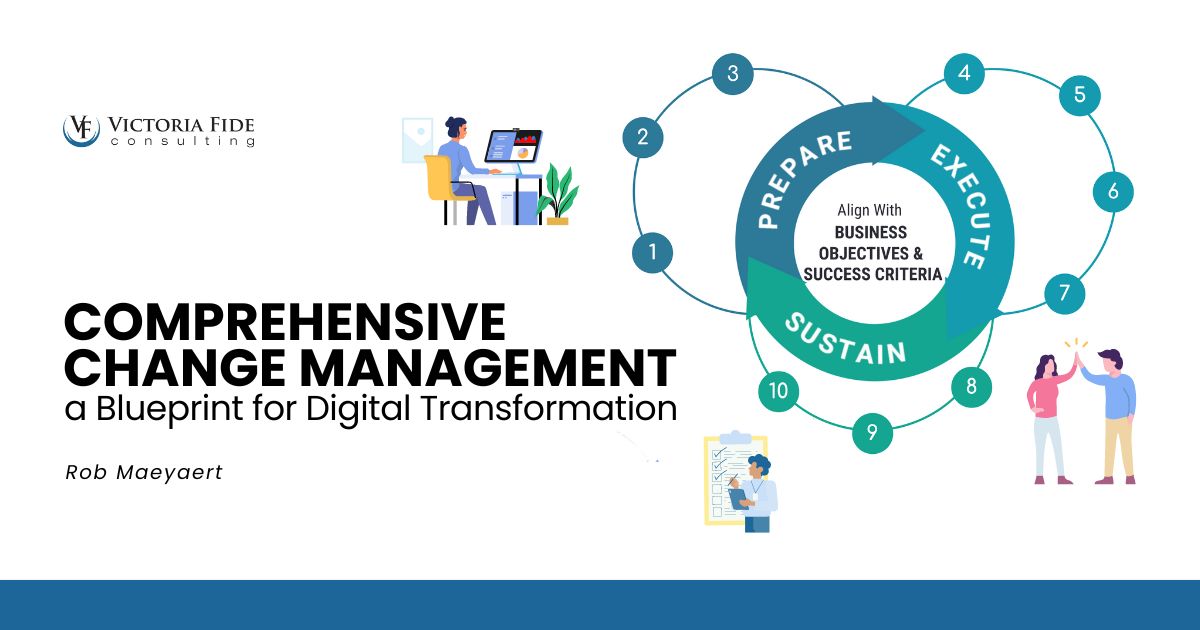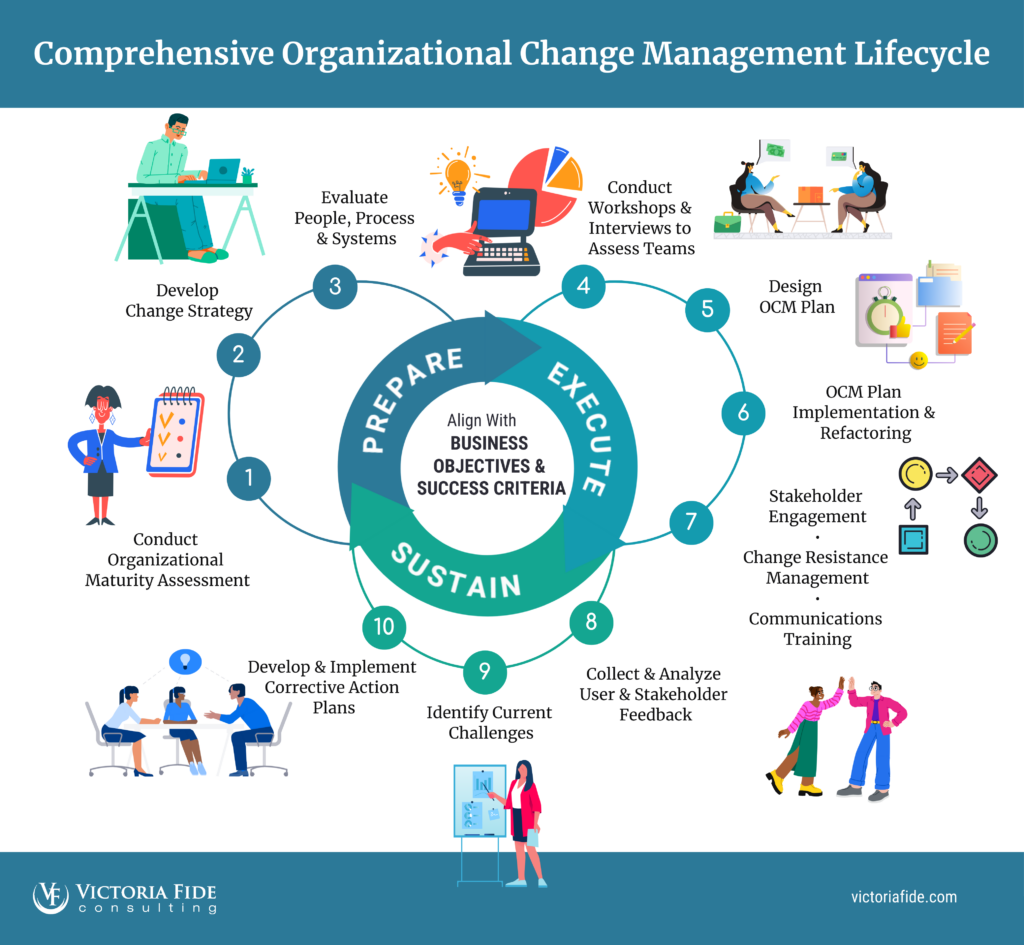
Comprehensive Change Management: A Blueprint for Digital Transformation
Organizational Change Management (OCM) is a discipline that focuses on managing changes within an organization by prioritizing the human element of change. OCM is not just a one-time event, but rather an ongoing process that organizations must continuously adapt and evolve to stay competitive in today’s fast-paced business environment.
As businesses grow, they often undergo significant changes in their processes, technologies, strategies, and even their culture. These changes can range from minor adjustments to major transformations that affect the entire organization. However, regardless of the size or scope of change, it is crucial for organizations to have a structured approach to managing these transitions effectively.
Because change management is such a critical element for successful transformations, Victoria Fide weaves the strands of change management through every stage of our Process for Transformational Change. In this article, we will provide an overview for what it looks like to undertake a significant technological transformation with a holistic approach focused on the most important resource a company has: its people.

Table of Contents
Prepare: Laying the Foundation for Transformation
Conduct an Organizational Maturity Assessment
Organizational Maturity is an organization’s ability to adapt to change. Considering digital transformation is all about change, it stands to reason that organizations with low organizational maturity will struggle greatly with their transformational efforts.
Knowing the level of your organization’s maturity will significantly impact your change strategy, which is why we recommend conducting an organizational maturity assessment early on in the prepare stage.
Develop Change Strategy
Building a strategic change management strategy tailored to an organization’s specific needs can result in higher adoption rates, a smoother transition, less change resistance, quicker realization of benefits, bigger ROI, and more sustainable change.
A comprehensive strategy covers many facets of change, including leadership alignment, communication plan, stakeholder engagement, organizational culture and alignment, and training.
Evaluate People, Processes and Systems
It does no good to plan a route toward a “future state” if you are unaware of your current state. When preparing to manage the change, it’s essential to objectively and thoroughly evaluate your people, processes and systems.
People: Assessing your people provides you with an objective inventory of current skillset, character traits, availability, and resources. The assessment – generally performed by project leaders, stakeholders, or sponsors – will aid in identifying gaps and determining how to fill them through external consultants, staff augmentation, or outsourcing. It will also greatly inform any training or communication plans.
Processes: Too often, business leaders are unaware of the reality of their business processes, which in turn can skew their expectations for the transformation. The primary goal of the Enterprise Process Review is to garner an accurate understanding of the current processes and to record them with proper, comprehensive documentation.
Systems: Finally, it’s vital to review current systems and technology infrastructure as well as the people driving the technology within your IT department. Take into account department structure, technical expertise, and support and maintenance. By carefully considering these areas, you can better understand whether your IT department is ready to support and lead the digital transformation, or if there are capability gaps that need closing—be it through hiring, training, or partnering with specialized service providers.
Execute: Implementing the Change
Conduct Workshops & Interviews to Assess Teams
To effectively manage change in your organization, you must have a clear picture of your teams. This can be achieved by interviewing, assessing, and conducting workshops with the different teams involved in the transformation. This will give you insights into their strengths and weaknesses, their motivations and personalities, and how best to leverage them for project success.
OCM Plan Implementation & Refactoring
With a solid understanding of your organization’s current state and the people involved, it is time to implement your change management plan. This involves communicating effectively with stakeholders, keeping employees informed and engaged, providing training and support, and addressing any resistance or challenges that may arise.
However, change plans are not set in stone. As the transformation progresses, it is essential to regularly reassess and refactor the OCM plan as needed. This will ensure that the plan remains relevant and effective throughout the entire process.
Shareholder Engagement, Change Resistance Management, Communications Training
During the course of the project execution, it’s critical to continue to engage stakeholders. By engaging stakeholders in targeted, strategic ways, you can leverage the most impactful change agents within your organization, reducing risks and improving the results of your project.
People seldom enjoy changing the way they work, and even the most well-trained employees can sandbag a DX project through passive-aggressive behaviors and attitudes. Managing change resistance is a foundational aspect of change management. Relying on previous assessments, interviews, and survey results can help leaders form a plan for effectively reducing resistance within their team using OCM best practices.
Miscommunication often lies at the heart of many conflicts. It is vital to ensure that everyone is aligned, well-informed, and equipped with accurate information to prevent misunderstandings.
Sustain: Nurturing the Culture for Continued Success
Although the execution of the digital transformation is complete, the long-term success of the transformation requires additional support throughout the Sustain stage.
Collect & Analyze User & Stakeholder Feedback
After go-live, it’s necessary to collect and analyze feedback both from users and from relevant stakeholders. This valuable information can help identify areas for improvement and potential roadblocks that may have been overlooked during the planning and execution stages.
Identify Current Challenges
There may be some unexpected challenges that arose during or after execution. Now is the time to identify and address them to ensure the sustainability of the transformation.
Develop & Implement Corrective Action Plans
Once the challenges and their root causes are identified, you can begin to develop and implement corrective action plans. These plans should address the issues and provide a path forward for sustained success.

Transformation is not easy, but it doesn’t have to be impossible. Take control of your project’s success today and schedule a free 30-minute consultation to find out how Victoria Fide can equip you for transformational success.
A Comprehensive Approach to Organizational Change Management
Digital transformation isn’t just about implementing new technology; it’s about guiding your most important resources and empowering them to drive the transformation in a meaningful, sustainable fashion. Organizational change management is not only crucial for the success of a digital transformation, but it can equip companies for long-term health and growth.
A holistic OCM approach involves tailoring the strategy to the organization’s specific needs, evaluating people, processes and systems, conducting workshops and interviews to assess teams, implementing an OCM plan, and sustaining the transformation through ongoing feedback collection and corrective action plans.
By implementing a holistic approach to OCM, organizations can ensure a smoother transition, higher adoption rates, and sustainable change for continued success in the ever-evolving digital landscape. For more resources – including OCM training, assessments, and end-to-end digital transformation guidance – contact Victoria Fide today. We combine industry best practices with business prowess to help companies succeed in leveraging technology for positive, transformational change.
